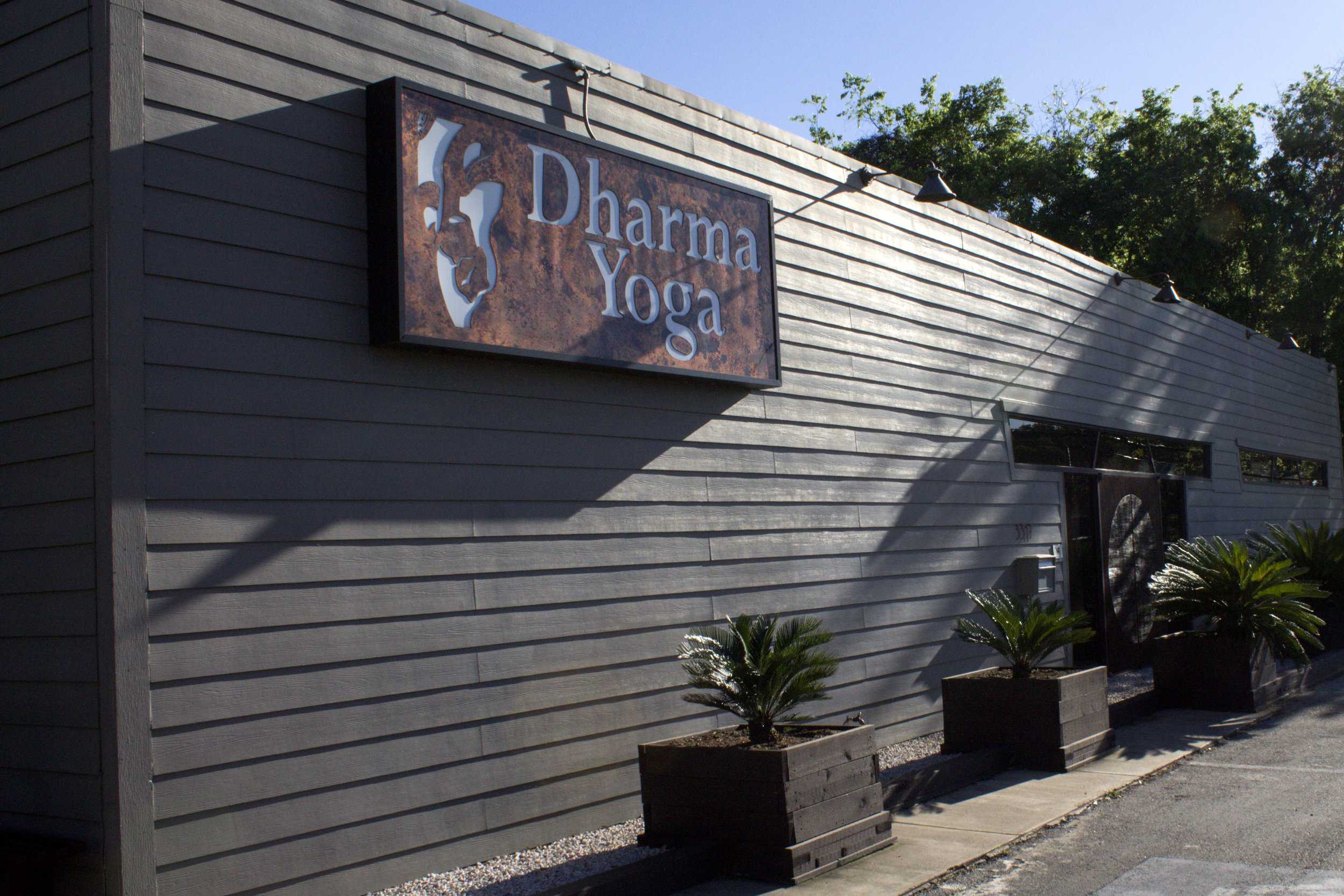While a lot of modern yoga seems to be branded as an exercise trend, local studio owners share the original purposes behind the practice.
Story by Rochelle Friedewald
Photos by Ravin Lee
Today, yoga is one of the fastest growing exercise industries in the country. According to surveys conducted by the American College of Sports Medicine, yoga is ranked among the top ten trends for 2014 and 2015, with over 10% of Americans participating. Lululemon, the leading women’s athleisure brand, has made high end, fashionable yoga pants a multimillion dollar industry. Today, the practice can be found in every gym around the country.
Eastside Yoga is located in East Austin on 11th Street and Waller.
As the yoga world becomes cluttered with fashionable brands and get-slim-quick DVD guides, the ideas behind the ancient practice are murky. “First, it’s important to understand what is the purpose and meaning of yoga,” says Steven Ross, cofounder of Eastside Yoga. “The word translates to union or oneness where the individual feels separate from their true essence. Their Divine reunites their awareness and this reunification is transformative. Obviously not an easy feat, but it’s all part of the progression of the soul journey.”
This definition might surprise many Western practitioners – yoga can be simplified as a mental movement towards spiritual peace. A lot of meaning tends to get lost in the modern context. Spiritual connectedness is replaced by what is largely just asanas, or the physical postures of the practice. “Even in a yoga-progressive city like Austin, most yoga studios practice what is essentially jazzercise,” says Keith Kachtick, co-founder of Dharma Yoga. “Traditional Indian Yoga and Tibetan Buddhism are both focused on one thing – waking up to what we truly are. Everything in our lives that is not Source Awareness boils down to little more than that one-inch dash between the birthdate and death date on our tombstones.” Source Awareness is the action of stripping away all earthly worries and getting back in touch with your True Self; yogis say that only then will one be free of the human fear of death and become in touch with their true compassion.
Dharma Yoga is situated in East Austin at 3317 Manor Road.
In short, the overall purpose of yoga, which has stood the test of over 5,000 years of time, is to calm one’s mind, align with one’s true self and let go of the earthly cycle of life and death, ultimately achieving enlightenment.
However, this definition doesn’t seem to ring true for some of the biggest yoga chains in the country. Brands like CorePower Yoga, Yoga Works and Jivamukti offer fast-paced classes in large mirrored rooms with dozens of students, a style of teaching that has little to do with spiritual enlightenment. Along with criticisms of westernizing a practice with deep religious and cultural ties, the accessibility of yoga is an issue that raises many eyebrows. Rates for classes, entry level costs of “yoga” clothes are all reasons why the industry is worth over $27 billion dollars, and why popular public perception paints the ancient discipline as merely a pastime for the trendy, health-conscious and privileged millennial.
With all the misinformation about such a coveted practice, several local Austin studios work to keep their practices traditional, spiritually satisfying and part of the community. Eastside Yoga, founded in 2009 by couple Steven Ross and Elsa Bui, teaches authentic practices like hatha yoga and vinyasa flow to keep traditions alive. While these techniques aim to improve the body’s wellness, the focus at Eastside Yoga is more metaphysical. “Meditation is the most important Yoga technique and the least practiced by western yogis,” says Ross. “At Eastside Yoga, we chant Gayatri every Sunday to uplift the vibration in our space and in our consciousness. In the case of this particular mantra, it is said to be a prayer and a contemplation to enlighten our intellect.” Across town, Dharma Yoga upholds similar ideals of the traditional yoga practice, while also utilizing the Three Jewels of Buddhism.
Other Austin studios not only focus on helping individuals achieve inner peace but also strive to help the community. Sanctuary Yoga, Austin’s only nonprofit studio, donates portions of its proceeds for every class to the Amala Foundation, a humanitarian organization dedicated to inspiring underserved young people. “Programs focus on social-emotional development, leadership, cultural sharing, and mindfulness training,” says Audrey Fouss, owner of Sanctuary.
Sanctuary Yoga is owned and operated by the Amala Foundation in South Austin.
Other unique twists on the traditional practice include Dharma’s emotional rehabilitation sessions. “Several of Dharma’s yoga teachers are therapists certified in women’s issues, including trauma from cancer, sexual abuse, eating disorders, infertility and perinatal loss,” says Kachtick. “Sessions often include work on a Thai Yoga mat to release constricted emotional history held in the body.”
While most of the traditional practices in these studios are well-intentioned and employ certified teachers, some perceive any departure from centuries-old techniques as an exploitation of a cultural narrative. Critics point out that most Western practices encourage students to buy or rent expensive mats to participate in class – techniques that date back to 15th century India did not require a mat. Classes in the studios here usually have at least ten students per class while early yogis typically only taught one student at a time. Costs per class are still seen as large barriers of entry for a practice that is framed as a spiritual necessity. With the exception of donation-based studios like Black Swan, the majority of studios in Austin run around $50-60 a month.
Others say critiques of Western yoga are too condemning, considering the years of change the practice has experienced. “Occasionally people will come up to me and ask, sometimes anxiously, which parts of modern yoga practice are ‘real,’’’ says Michelle Goldberg, author of “The Goddess Pose: The Audacious Life of Indra Devi (the mother of Western yoga)”. “A lot of people turn to yoga instead of, say, pilates, because they want to partake in deep tradition. But most people also need to understand that every religious and cultural practice undergoes a huge amount of adaptation and reinvention as it moves through time and space.”
In a stressful and materialistic world, it’s easy to understand why millions are flocking to a practice that encourages physical as well as mental balance. While the Western world toes the line between cultural appreciation and appropriation, modern concepts and interpretations of yoga connect us through a simple human need to create and recreate oneself from within.













































